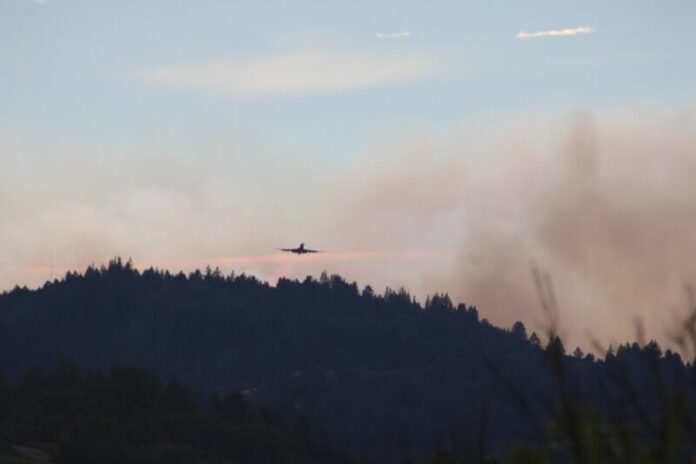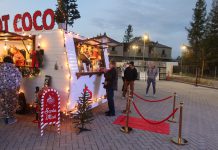In an eight-part series we look back at the world that was, here in our little corner of it. 2020 was a year of challenges. We’ll be publishing this eight piece work daily as we work to the new year. Today’s piece is on the fires that spread through the county and the challenges of dealing with public safety power shutoffs.
Fires
A rare summer thunderstorm that boomed across Sonoma County started two wildfires in west county on Aug. 17 — the Walbridge Fire started west of Healdsburg and the Meyers Fire started north of Jenner.
As of Aug. 20, the Walbridge Fire was at 1,500 acres and growing at 0% containment and the Meyers Fire was at 25 acres at 0% containment.
With years of overgrown brush and dried tinder, the Walbridge Fire made its way down drainage basins and through the crowns of trees of redwood forests burning a total of 55,209 acres.
The fire — which was part of the LNU Complex Fire, a 363,220-acre fire composed of the Hennessy Fire, Walbridge Fire and Meyers Fire — forced the evacuation of several thousand Sonoma County residents including the residents of the Mill Creek Road neighborhood west of Healdsburg.
The fire slithered its way into Armstrong Woods and devastated the Mill Creek Road area, including the historic Daniels School, which had been meticulously renovated in January.
A total of 1,491 structures were destroyed in the LNU Complex Fire.
On Aug. 23, Healdsburg Fire Marshal/Division Chief Linda Collister tirelessly spent most of her day driving around the scorched and smoky areas of Mill Creek, Wallace Creek and Chemise Road, checking on homes behind the fire front, a tactical term called fire front following.
Collister said it would be a shame to lose a home just three days after it was saved, which is why fire front following is so important.
While the fire affected the lives of many it also affected the fall grape harvest. As Dry Creek and Russian River valleys filled with smoke and an orange haze, some wineries had to halt their grape harvest due to the threat of the fire.
According to reporting by Rollie Atkinson, “Dozens of wineries lay along the periphery of the fire zones along River Road, Westside Road and in western Dry Creek Valley. Guerneville’s Korbel Winery ceased production work last Wednesday and diverted ripening grapes to its Bakersfield Heck Cellars. Elsewhere, the dangerous smoke-filled air has halted grape picking until the skies clear.”
Our county wasn’t in the clear yet though, as the Glass Fire started on Sept. 27 in Napa County and quickly jumped into eastern Sonoma County. The Glass Fire was fully contained on Oct. 20, after burning over 67,484 acres and destroying 1,555 structures, including 308 homes and 343 commercial buildings in Napa County, as well as 334 homes in Sonoma County. Thankfully, no injuries or deaths were reported as a result of the fire, though an estimated 70,000 people were under evacuation orders. CalFire officials lifted evacuation orders on Oct. 19.
While Windsor was spared a direct hit from the Walbridge Fire, it didn’t escape entirely unscathed after it was discovered that the lights used to decorate and facilitate the annual Charlie Brown Christmas Tree Grove had burned along with the barn they were being stored in.
The annual event, put on by the People4Parks Foundation, fills the Town Green with lights, snow, holiday cheer and hundreds of Christmas trees decorated by local groups and businesses.
Lorene Romero, vice chair of the foundation and the Director of the Windsor Chamber of Commerce, said the foundation was notified that the lights — primarily those used to decorate the central kiosk and the parks natural trees along with “dancing” icicle lights — had been lost. The lights were valued at $12,000 to $15,000.
The lights were being stored at Renninger Ranch, as Renninger Electric has been the electrical contractor for the grove.
“If you look at the middle kiosk all lit up — we joke you can see it from space — all those lights and all that are strung around, but not the ones on the individual Christmas trees, those are brought by individuals, but all the other lights hung around the grove,” Romero said. “The snow machine is safe, and the barrels (the trees are put on) live in Keiser Park in metal containers so they’re safe.”
In mid-September it was announced that Christmas was saved when a GoFundMe started by Romero and Mayor Dominic Foppoli raised enough money to not only replace the lights that were lost but add a few more as well.
Power outages
As Sonoma County, and the state, faced down another year of trying to avoid wildfires, PG&E announced in May it was implementing plans to try to keep the Public Safety Power Shutoffs (PSPS) shorter and more targeted.
But those were not the only power outages happening this year, as increased demand on the power grid forced the implementation of flex alerts and rolling power outages in August, unfortunately in some cases coinciding with and delaying the reopening of schools in distance learning.
From August through November it felt like every other week brought a red flag warning, a power outage or wildfire. There was even a red flag warning in December.
Windsor preparedness
With this becoming the new normal, Windsor formed its own community preparedness organization, the Windsor Neighborhood Community Program (WNCP) for the town of Windsor to help create resilience and involvement in the community, facilitated by the Windsor Wellness Partnership.
“The overall goal of WNCP is to assist Windsor residents in being more resilient and more involved with their community,” said Diana Borges, Windsor Neighborhood Community Program coordinator at the time of launch. “Early this year, Windsor Wellness Partnership organized a ‘pilot test’ neighborhood program with about six neighborhood team leaders to assist our community in being better prepared and to increase communication.”
Borges became the WNCP coordinator in September and researched existing neighborhood programs that address emergency preparedness. Based on the research, Windsor Wellness Partnership decided to use Citizens Organized to Prepare for Emergencies (COPE) to address the emergency preparedness/response portion of the program and subsequently developed WNCP.
However, the WNCP program has three main areas it addresses; emergency prevention and response, community building and crime prevention.
The WNCP is using the existing COPE program for the emergency prevention and response portion of their plan. The Windsor COPE group is part of COPE Northern Sonoma County, of which there are more than 30 groups.
“COPE provides a model built upon neighbor helping neighbor before, during, and after an emergency to foster community preparedness,” said Borges. “COPE offer various services and opportunities to support preparedness efforts for emergencies such as earthquakes, wildfires, floods and other natural and man-made emergencies. During an emergency, participants get current and valuable information about the situation through the COPE communication chain.”
Community building activities could include things like neighborhood cleanups, neighborhood meetings and parties, activities to reduce waste, save water, garden sharing, holiday parties and contests.








